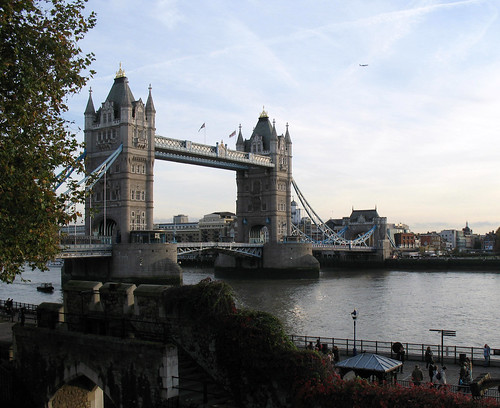![]()
A brief history from Wiki:
Background
In the second half of the 19th century, increased commercial development in the East End of London led to a requirement for a new river crossing downstream of London Bridge. A traditional fixed bridge could not be built because it would cut off access by tall-masted ships to the port facilities in the Pool of London, between London Bridge and the Tower of London.
A Special Bridge or Subway Committee was formed in 1876, chaired by Sir Albert Joseph Altman, to find a solution to the river crossing problem. It opened the design of the crossing to public competition. Over 50 designs were submitted, including one from civil engineer Sir Joseph Bazalgette. The evaluation of the designs was surrounded by controversy, and it was not until 1884 that a design submitted by Sir Horace Jones, the City Architect (who was also one of the judges),[5] was approved.
Jones’ engineer, Sir John Wolfe Barry, devised the idea of a bascule bridge with two towers built on piers. The central span was split into two equal bascules or leaves, which could be raised to allow river traffic to pass. The two side-spans were suspension bridges, with the suspension rods anchored both at the abutments and through rods contained within the bridge’s upper walkways.
Construction
Construction started in 1886 and took eight years with five major contractors – Sir John Jackson (foundations), Baron Armstrong (hydraulics), William Webster, Sir H.H. Bartlett, and Sir William Arrol & Co.[6] – and employed 432 construction workers. E W Crutwell was the resident engineer for the construction.[7]
Two massive piers, containing over 70,000 tons of concrete,[5] were sunk into the riverbed to support the construction. Over 11,000 tons of steel provided the framework for the towers and walkways.[5] This was then clad in Cornish granite and Portland stone, both to protect the underlying steelwork and to give the bridge a pleasing appearance.
Jones died in 1887 and George D. Stevenson took over the project.[5] Stevenson replaced Jones’s original brick façade with the more ornate Victorian Gothic style, which makes the bridge a distinctive landmark, and was intended to harmonise the bridge with the nearby Tower of London.[7] The total cost of construction was £1,184,000[7] (£100 million as of 2012).[8]









This is a superb composition of what IMO is London’s greatest landmarks Cherie…. they sure new how to build things to last back in 1886:-)….peter:)
Thank you I took it from the walls inside the Tower of London, it gave a very nice view of the bridge.
I took it from the walls inside the Tower of London, it gave a very nice view of the bridge.
No wattle and daub there, Cherie.
No, quite a bit more high tech
I must be a bit of a heretic among Lndoners as I think Tower Bridge is ghastly!
It is interesting that you find it ghastly!
Server seems to have vanished!!
Everything seems to be working fine for me… Unless I have misunderstood what you mean.
Working fine now, thanks.